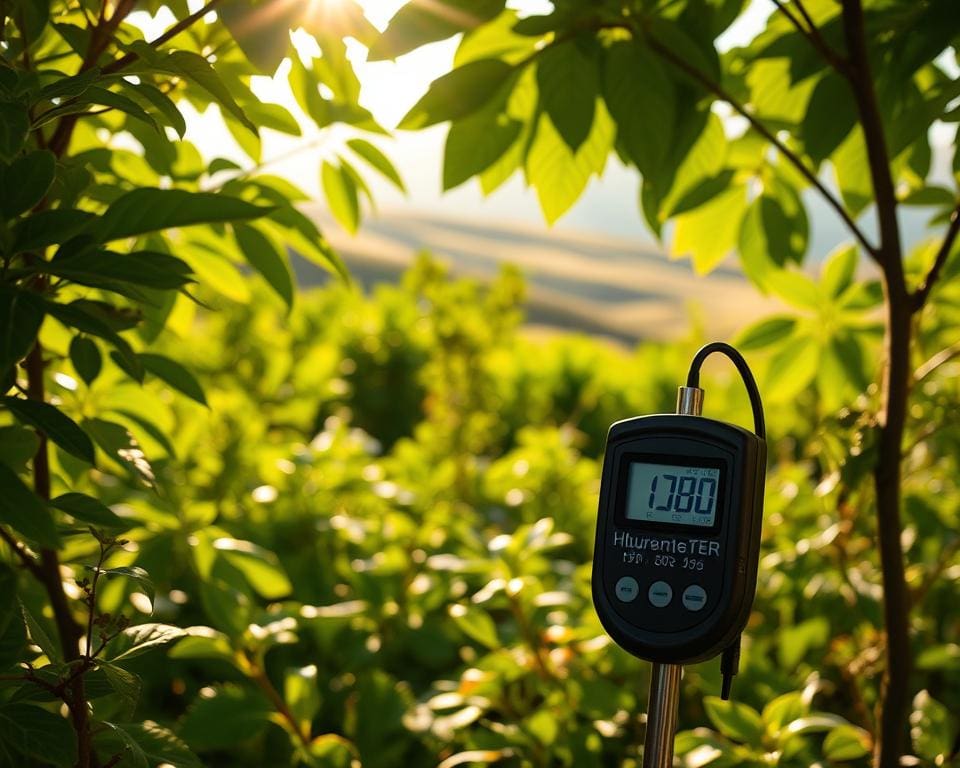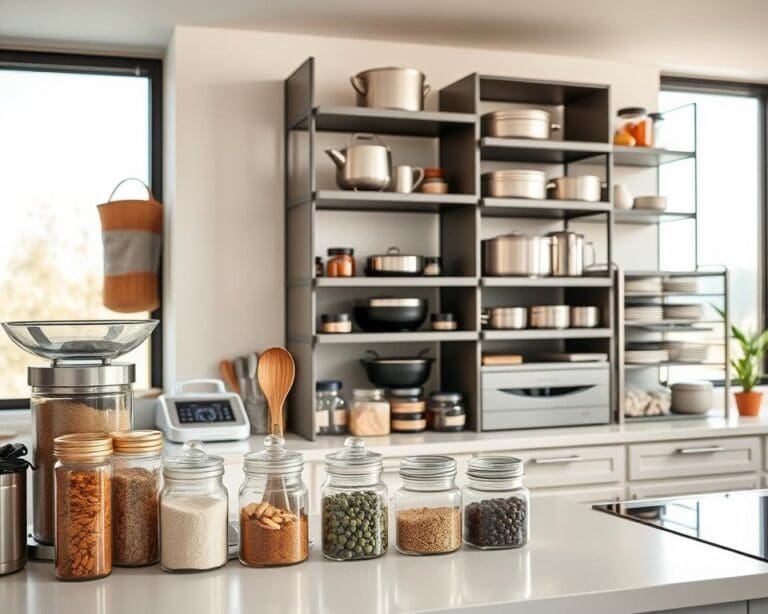Understanding how to measure real-time garden humidity is vital for any gardener aspiring to cultivate healthy plants. Garden humidity measurement plays a significant role in determining moisture levels within both the soil and the air, aspects that directly influence plant vitality. By exploring various methods for measuring outdoor humidity, you empower yourself not only to maintain optimal growing conditions but also to enhance the overall health of your plants.
Understanding Garden Humidity
Garden humidity plays a vital role in the overall health and growth of plants. By exploring garden humidity, one can better appreciate its components, including the moisture content in both the air and the soil. Such an understanding creates a holistic view of a garden’s ecosystem, allowing gardeners to cater to their plants’ specific needs.
What is Garden Humidity?
Garden humidity refers to the level of moisture present in the atmosphere above a garden and within the soil. This element influences plant life significantly, as it affects processes like transpiration and nutrient absorption. Plants rely on an optimal balance of garden humidity to thrive, showcasing how interconnected these environmental factors are.
The Importance of Measuring Humidity
Measuring humidity holds great significance for any serious gardener. Accurate readings help optimise watering schedules, enabling gardeners to avoid the pitfalls of over or under-watering. Understanding garden humidity can enhance plant growth and health, offering insight into the precise moisture levels required for different plant types. Regular monitoring fosters an environment where plants can flourish, leading to a vibrant and thriving garden.

How do you measure real-time garden humidity?
Measuring real-time garden humidity plays a significant role in successful gardening. Utilising reliable tools and techniques ensures that plants receive the appropriate moisture levels for optimal growth. This section explores various tools for measurement that elevate gardening practices by delivering accurate humidity readings.
Tools and Techniques for Measurement
A variety of devices exist for measuring real-time garden humidity. The most common tools include:
- Hygrometers: Ideal for gauging ambient humidity levels, these devices provide readings that help you understand the environmental conditions impacting your garden.
- Soil Moisture Meters: These practical devices insert directly into the soil, offering insights into the moisture content at plant root levels, crucial for making timely watering decisions.
- Real-time Garden Moisture Monitors: Equipped with advanced sensors, these monitors track humidity levels continuously, allowing gardeners to access data remotely through compatible apps.
Benefits of Real-Time Monitoring
The advantages of using real-time monitoring for garden humidity are numerous. Timely data aids in:
- Informed Decisions: By receiving up-to-the-minute readings, gardeners can adjust their watering schedules, ensuring plants get the right amount of moisture when needed.
- Improved Yield: Consistent monitoring leads to healthier plants, resulting in better yields during harvest.
- Enhanced Plant Vitality: Keeping moisture levels in check mitigates risks related to overwatering or underwatering, promoting robust plant growth.
Integrating these tools for measurement into your gardening routine fosters a thriving garden environment, ultimately creating a more enjoyable and fruitful gardening experience.
Types of Garden Humidity Sensors
When selecting the right garden humidity sensors, it is essential to understand the various types available, including analog sensors, digital sensors, and wireless options. Each type serves unique purposes, catering to different gardening styles and preferences.
Analog vs Digital Humidity Sensors
Analog sensors offer a traditional approach to measuring moisture levels, often displaying readings through a simple dial. These devices can be reliable for gardeners who appreciate straightforward readings without the complications of electronics. On the other hand, digital sensors provide precise measurements, often incorporating advanced features such as data logging and easy readouts on LCD screens. Many gardeners favour digital sensors for their accuracy and ability to capture fluctuations in humidity over time.
Wireless Sensors and Their Advantages
Wireless sensors have revolutionised the way gardeners monitor humidity levels. By eliminating the need for cumbersome wiring, these devices allow flexibility in placement and ease of accessibility. With the integration of smart technology, wireless sensors enable real-time monitoring from remote locations, which is invaluable for busy gardeners or those managing multiple locations. The convenience of receiving notifications on mobile devices enhances the overall gardening experience.
Choosing the Right Garden Humidity Gauge
Selecting the most suitable garden humidity gauge can significantly enhance your gardening experience. A variety of key features will determine the effectiveness and user-friendliness of your gauge, contributing to more accurate gardening decisions.
Key Features to Consider
When choosing humidity gauge, consider the following features for optimal performance:
- Accuracy: Ensure the gauge provides reliable readings, as precision is vital for maintaining healthy garden conditions.
- Range: Look for a device that covers the humidity levels typical to your plants, allowing for versatility across different growth phases.
- Durability: Choose a gauge built to withstand outdoor conditions, ensuring longevity for consistent monitoring throughout the seasons.
- Ease of Use: Opt for models with intuitive interfaces and clear displays, facilitating quick readings and adjustments.
Top Brands in the Market
Several brands have established themselves in the market for their reliability and innovative features. When considering your garden humidity gauge, explore these top brands:
- Gardena: Known for high-quality tools, Gardena offers gauges that integrate seamlessly with their irrigation systems.
- Flora Meter: This brand is praised for its accuracy and user-friendly design, ideal for both novice and experienced gardeners.
- Innova: A solid choice for those looking for advanced features, such as wireless connectivity and smartphone integration for ease of monitoring.
Installing Your Outdoor Humidity Monitoring Device
Successfully installing your outdoor humidity monitoring device requires careful consideration of placement and calibration. Selecting the right location will significantly affect the accuracy of readings and the functionality of the device. Implementing best practices placement will ensure optimal performance while reducing the risk of external interference. Furthermore, understanding calibration procedures for accurate readings will empower gardeners to make informed decisions about their plants’ care.
Best Practices for Placement
To achieve the most reliable data, follow these guidelines for placing your humidity monitoring device:
- Install the device in a shaded area to prevent direct sunlight from affecting the readings.
- Position the sensor at plant height; this will provide relevant data for the immediate environment of your plants.
- Avoid placing the device near walls or large objects that could obstruct air movement.
- Ensure the device is within range of your Wi-Fi connection if it is wireless.
Calibration Procedures for Accurate Readings
Calibration is crucial for ensuring your humidity monitoring device provides trustworthy data. Follow these steps for effective calibration:
- Refer to the manufacturer’s instructions for specific calibration procedures.
- Use a known humidity reference, such as a hygrometer, to compare readings.
- Adjust the settings on your device based on this benchmark, ensuring it accurately reflects the actual moisture levels.
Tracking Garden Moisture Levels Over Time
Maintaining optimal garden health requires diligence and awareness about moisture conditions. For gardeners, the practice of tracking garden moisture levels over time plays a crucial role in enhancing plant care. By delving into understanding moisture patterns, one can predict the needs of plants, ensuring they receive the right amount of water throughout their growth stages.
Understanding Moisture Patterns
Detecting trends in moisture levels allows gardeners to adapt to changing weather conditions and plant needs. Recognising if certain areas of the garden retain more moisture than others helps inform targeted watering practices. Understanding moisture patterns can lead to more efficient use of water resources, promoting sustainability while encouraging stronger plant development.
Keeping a Moisture Log for Better Management
Implementing moisture log management serves as a means of historical context that supports informed gardening decisions. By recording moisture readings at regular intervals, gardeners can identify specific trends that may influence future watering schedules. A well-maintained log can reveal how different plant types respond to varying moisture levels over time. With this insight, optimised watering strategies become achievable, bolstering overall garden health.
Improving Plant Care with Real-Time Data
Utilising real-time data for gardening brings a transformative edge to the practice of plant care. Gardeners can access immediate moisture levels, allowing for precise adjustments to watering schedules. This proactive approach not only enhances efficiency but also ensures that plants receive the right amount of water, fostering healthier growth.
Adjusting Watering Schedules
With real-time data, gardeners can tailor their watering schedules to meet specific plant needs. By monitoring humidity levels, one can determine when to water and how much is necessary. Benefits of this method include:
- Reduction in water wastage
- Enhanced growth due to optimal moisture
- Decreased risk of root rot from overwatering
Identifying Potential Plant Stress
Real-time data provides valuable insight into plant conditions, allowing for early detection of stress indicators. Signs such as wilting leaves or colour changes can often be linked to improper moisture levels. By closely observing humidity data, gardeners can act swiftly to mitigate these issues. Steps for effective stress identification include:
- Regularly checking humidity readings
- Monitoring changes in plant appearance
- Adjusting care routines based on observed patterns
Innovative Solutions for Garden Humidity Measurement
As we delve into the realm of garden humidity measurement technologies, we find ourselves at the cusp of a gardening revolution. Smart irrigation systems are emerging as leading innovative solutions, allowing gardeners to tailor their watering routines based on real-time humidity data. These systems utilise advanced sensors that not only track moisture levels but also integrate with weather forecasts to optimise water usage, thereby conserving resources and ensuring plants thrive.
Automated humidity monitors have also taken centre stage, enabling gardeners to keep tabs on their garden’s environmental conditions effortlessly. These devices connect to smartphones and provide alerts about changes in humidity levels, empowering gardeners to respond swiftly to their plants’ needs. Such innovative solutions exemplify how technology can enhance gardening experiences, showcasing a seamless blend of tradition and modernity.
As we look towards the future of gardening, it is evident that these technological advancements will continue to play a pivotal role. Adopting such innovative garden humidity measurement technologies not only simplifies the process of plant care but also encourages sustainable practices. With the integration of smart tech in our gardens, we are paving the way for a more efficient and responsible approach to nurturing our green spaces.









